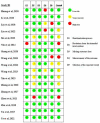Effectiveness of acupuncture as auxiliary combined with Western medicine for epilepsy: a systematic review and meta-analysis
- PMID: 37547148
- PMCID: PMC10397512
- DOI: 10.3389/fnins.2023.1203231
Effectiveness of acupuncture as auxiliary combined with Western medicine for epilepsy: a systematic review and meta-analysis
Abstract
Background: Although more and more clinical studies have shown that acupuncture as an auxiliary combined with Western medicine is effective in the treatment of patients with epilepsy, no systematic reviews of acupuncture as a treatment for epilepsy have been published. Hence, we conducted this meta-analysis to evaluate the effect of acupuncture treatment on patients with epilepsy.
Methods: This study retrieved randomized controlled trials (RCTs) of acupuncture treatment for epilepsy from various electronic databases including PubMed, Embase, Cochrane Library, China National Knowledge Infrastructure, Chinese BioMedical Literature Database, and Wangfang database. These studies evaluated the effectiveness of acupuncture as an auxiliary treatment combined with Western medicine for patients with epilepsy. The methodological quality of the studies was assessed using the Cochrane Handbook for Systematic Reviews of Interventions.
Results: A total of 17 RCTs involving a total of 1,389 participants were included. The results showed that acupuncture combined with Western medicine improved the effective rates of treatment (OR: 4.28; 95% CI: 3.04-6.02; p < 0.001), and reduced the seizure frequency of patients (SMD: -3.29; 95% CI: -3.51 to -3.07; p < 0.001) and the EEG discharge frequency (SMD: -5.58; 95% CI: -7.02 to -4.14; p < 0.001). Regarding the quality of life and adverse events, the acupuncture group was superior to the control group in improving the overall quality of life of patients with epilepsy (SMD: 14.41; 95% CI: 12.51-16.32; p < 0.001) and decreased adverse events (OR: 0.38; 95% CI: 0.23-0.63, p < 0.001).
Conclusion: The results of the analysis suggested that acupuncture combined with Western medicine is probably helpful in patients with epilepsy, but strong supportive data are not yet available. Given that this study is based on a low to moderate evidence-based analysis, the conclusions should be viewed with caution.
Systematic review registration: PROSPERO, identifier no. CRD42023409923.
Keywords: acupuncture; epilepsy; meta-analysis; randomized controlled trials; systematic review.
Copyright © 2023 Xue, Zeng, He, Xu and Ren.
Conflict of interest statement
The authors declare that the research was conducted in the absence of any commercial or financial relationships that could be construed as a potential conflict of interest.
Figures









Similar articles
-
Effect of acupuncture for non-motor symptoms in patients with Parkinson's disease: A systematic review and meta-analysis.Front Aging Neurosci. 2022 Oct 6;14:995850. doi: 10.3389/fnagi.2022.995850. eCollection 2022. Front Aging Neurosci. 2022. PMID: 36275001 Free PMC article.
-
Acupuncture treatment vs. cognitive rehabilitation for post-stroke cognitive impairment: A systematic review and meta-analysis of randomized controlled trials.Front Neurol. 2023 Feb 9;14:1035125. doi: 10.3389/fneur.2023.1035125. eCollection 2023. Front Neurol. 2023. PMID: 36846126 Free PMC article.
-
Efficacy of acupuncture for functional constipation in elderly: a systematic review and meta-analysis.Front Med (Lausanne). 2024 Dec 4;11:1473847. doi: 10.3389/fmed.2024.1473847. eCollection 2024. Front Med (Lausanne). 2024. PMID: 39697209 Free PMC article.
-
Efficacy and Safety of Acupuncture in Renal Colic Caused by Urinary Calculi in Adults: A Systematic Review and Meta-Analysis.Evid Based Complement Alternat Med. 2022 Jul 4;2022:7140038. doi: 10.1155/2022/7140038. eCollection 2022. Evid Based Complement Alternat Med. 2022. PMID: 35832526 Free PMC article. Review.
-
Clinical evidence of acupuncture and moxibustion for irritable bowel syndrome: A systematic review and meta-analysis of randomized controlled trials.Front Public Health. 2022 Nov 24;10:1022145. doi: 10.3389/fpubh.2022.1022145. eCollection 2022. Front Public Health. 2022. PMID: 36589968 Free PMC article.
Cited by
-
Moxibustion pre-treatment attenuates seizure severity during status epilepticus and counteracts the proconvulsant function of the purinergic P2X7 receptor.Purinergic Signal. 2024 Sep 13. doi: 10.1007/s11302-024-10050-x. Online ahead of print. Purinergic Signal. 2024. PMID: 39271580
-
Efficacy and safety of herbal medicine combined with acupuncture in pediatric epilepsy treatment: A meta-analysis of randomized controlled trials.PLoS One. 2024 May 9;19(5):e0303201. doi: 10.1371/journal.pone.0303201. eCollection 2024. PLoS One. 2024. PMID: 38723054 Free PMC article.
-
Efficacy and safety of GLP-1 receptor agonists on weight management and metabolic parameters in PCOS women: a meta-analysis of randomized controlled trials.Sci Rep. 2025 May 13;15(1):16512. doi: 10.1038/s41598-025-99622-4. Sci Rep. 2025. PMID: 40360648 Free PMC article.
-
Cochrane reviews of acupuncture are dated, do not account for the specific effects of sham controls and likely underestimate the efficacy of acupuncture therapy.Integr Med Res. 2025 Sep;14(3):101195. doi: 10.1016/j.imr.2025.101195. Epub 2025 Jun 21. Integr Med Res. 2025. PMID: 40689021 Free PMC article. Review.
References
-
- Huang L. F., Liu X. L. (2020). Clinical observation of Chaigui Wendan Dingzhi decoction combined with acupuncture in the treatment of epilepsy. Bright Chin. Med. 3, 384–386.
-
- Kanner A. M., Ashman E., Gloss D., Harden C., Bourgeois B., Bautista J. F., et al. . (2018). Practice guideline update summary: efficacy and tolerability of the new antiepileptic drugs I: treatment of new-onset epilepsy: report of the guideline development, dissemination, and implementation Subcommittee of the American Academy of neurology and the American Epilepsy Society. Neurology 91, 74–81. doi: 10.1212/wnl.0000000000005755, PMID: - DOI - PubMed
-
- Li F. (2020). Efficacy and safety evaluation of acupuncture combined with sodium valproate in the treatment of early epilepsy. Chin. Convalesc. Med. 29, 140–142. doi: 10.13517/j.cnki.ccm.2020.02.011 - DOI
Publication types
LinkOut - more resources
Full Text Sources

